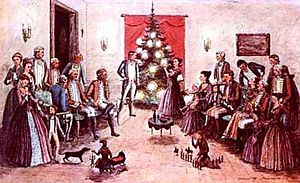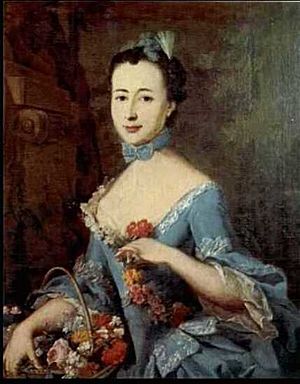Frederika Charlotte Riedesel facts for kids
Frederika Charlotte Louise von Massow, Baroness Riedesel zu Eisenbach (1746-1808) was a German writer and adventurer. She was the wife of General Friedrich Adolf Riedesel from Brunswick. She bravely joined him during the Saratoga Campaign in the American Revolutionary War. During this time, she kept a detailed journal. This journal offers a unique look at the war from her perspective. In her family's history, she was often called Charlotte. It was common for Germans back then to be known by one of their middle names.
Contents
Charlotte's Early Life and Marriage
Charlotte was born on July 11, 1746, in Brandenburg, Germany. Her father, Valentin von Massow, was a Prussian official. He had also been a Lieutenant General in the Prussian army. As a child, Charlotte traveled with the Prussian army. This experience taught her about the tough life of people who followed the army.
In 1762, Charlotte helped care for Lieutenant Colonel Riedesel. He had been hurt in a battle during the Seven Years' War. They got married that same year when Charlotte was just sixteen.
Friedrich Adolph Riedesel was a member of a noble family. Like all his male cousins, he had the title Freiherr, which means Baron. When they married, Charlotte became a Freifrau, or Baroness Riedesel zu Eisenbach. People said she looked more like a schoolgirl than a married woman at first. But she grew into a beautiful red-haired baroness.
In the years that followed, the Riedesels had two daughters, Gustava and Frederica. Charlotte was expecting their third daughter, Carolina, in 1776. This was when Brunswick signed a treaty to help Great Britain in the American colonies. Friedrich was promoted to General and became the commander of the Brunswick army. He often called Charlotte "Mrs. General."
General Riedesel sailed to America in 1776. Charlotte was to join him once their new baby was old enough to travel. Carolina was born in March. The family then sailed to England in May. Charlotte brought some old valuable items to sell in England. She hoped to get money for their travel expenses there.
"Mrs. General" Riedesel was welcomed by the English court. However, she and her daughters faced some rude comments in public. This was because her clothes were mistaken for French fashion. Charlotte waited for her ship to Canada in Bristol. It is said she learned English and British customs in just six weeks. General Riedesel wanted her to travel with a companion. So, she could not sail to Canada until April 1777.
Adventures in the American Revolution
Joining the Saratoga Campaign
Charlotte arrived in Canada and met Friedrich again in June. This was in Trois-Rivières. She received permission to go with the army south. They were joining General John Burgoyne's campaign to capture Albany. Her journals show her military background. She even criticized the lack of safety in the army camp.
Charlotte and her daughters followed the army in a calash, a type of carriage. She was with the army on September 19. She saw the Battle of Freeman's Farm with her own eyes. Her journals describe her evening in a nearby house. Wounded soldiers came there to rest. A young English officer slowly died there during the night.
Baroness Riedesel was making a meal on October 7 when the Battle of Bemis Heights began. The table, with its food, was quickly cleared. It was used to make a bed for General Simon Fraser. Charlotte spent the night caring for wounded soldiers, other women, and her own children. General Fraser died the next morning. That afternoon, the house caught fire. The Riedesel family had to leave quickly. General Fraser had asked to be buried at a special fort. Frederika watched the funeral while American cannons fired nearby.
Right after this, the British feared they would lose to the Americans. They decided to retreat to Canada. "Mrs. General" Riedesel was very critical of General Burgoyne. She even broke with the customs of the time to remind the General that his soldiers were starving.
After marching north through heavy rains, their equipment stuck in the mud. The Baroness found shelter near Saratoga, in what is now Schuylerville. This place is known as the Marshall House. It was a large wooden building. The stone cellar where Charlotte hid with her small children, other women, and wounded officers is still there.
Inside the house, you can still see beams broken by American cannon fire. There are also bloodstains on the floor. These were left by "one poor soldier," as the Baroness wrote, whose leg was hit by a cannonball. Three of the eleven cannonballs that Charlotte recorded hitting the building are on display. She spent days managing the crowded cellar. It became a safe place for women and wounded soldiers as the battle continued. A German soldier called her an "angel of comfort." He said she "restored order in the chaos."
The brave and sad events that happened in the Marshall House are clearly described in Baroness Riedesel’s famous diary. The Marshall House was added to the National Register of Historic Places in 2002. It was built in 1770. It is the only building left in the area from before the Battles of Saratoga. Today, it remains a private home.
Life with the Convention Army
After the British surrendered on October 17, Charlotte and her daughters became guests of General Philip Schuyler. The Riedesel family traveled with the defeated army to Boston. They were supposed to sail back to Europe from there. However, the American Congress did not agree to the surrender terms. So, the prisoners spent the next four years as the Convention Army.
The Convention Army was moved from Boston to Virginia in 1779. Here, General Riedesel became very ill while working in the garden. Baroness Riedesel spent her time caring for him as his nurse. Until he returned to Germany, General Riedesel could not sleep unless Charlotte was with him.

In late 1779, the Riedesels were allowed to move to New York City. While living there in 1780, Charlotte gave birth to their fourth daughter. They named her America. That same year, a smallpox sickness spread. Charlotte again became the nurse for her household. She may have even saved her husband's life, as he had given up hope.
Finally, in July 1781, the Riedesel family was allowed to leave New York. They traveled to Canada. Here, Charlotte gave birth to a fifth daughter, named Canada, but she did not survive. Before leaving Canada, General Riedesel took his wife to see the English soldiers under his command. The English soldiers honored Charlotte with military greetings. The Riedesels left for Germany in 1783. Charlotte is famous for saving the Brunswick regimental colors. She hid them in her mattress. She later returned them to Duke Karl Wilhelm Ferdinand.
Later Life and Legacy
The Riedesels had four more children, making nine in total. Six of them lived past their first year. After another military campaign in the Netherlands from 1788 to 1793, General Riedesel died in 1800. Charlotte returned to Berlin and published her war journals that same year. Her book became a very important firsthand story of the Saratoga Campaign. Baroness Riedesel died on March 29, 1808, in Berlin. She was buried with her husband in a family grave in Lauterbach.



